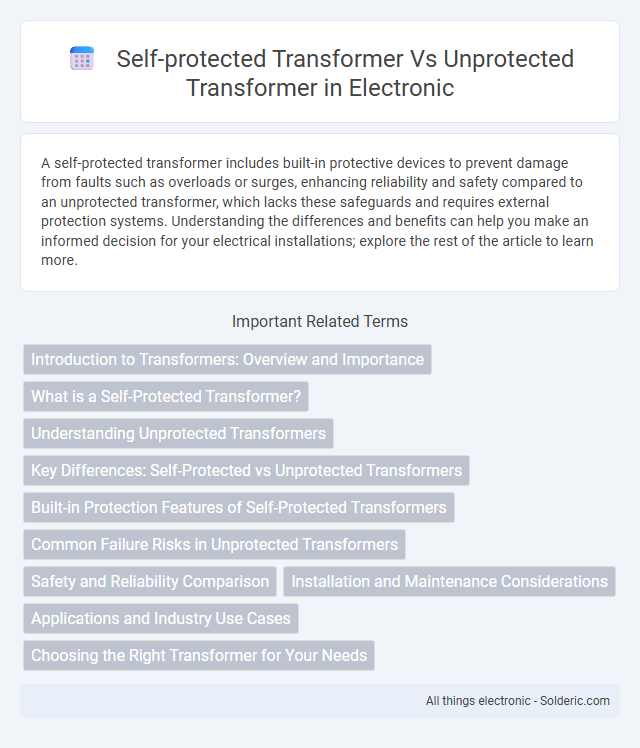A self-protected transformer includes built-in protective devices to prevent damage from faults such as overloads or surges, enhancing reliability and safety compared to an unprotected transformer, which lacks these safeguards and requires external protection systems. Understanding the differences and benefits can help you make an informed decision for your electrical installations; explore the rest of the article to learn more.
Comparison Table
| Feature | Self-Protected Transformer | Unprotected Transformer |
|---|---|---|
| Protection Mechanism | Integrated protective devices (fuses, relays, sensors) | No built-in protection; requires external devices |
| Fault Detection | Automatic internal fault detection and isolation | Manual or external fault detection |
| Maintenance | Reduced maintenance due to built-in monitoring | Higher maintenance through external inspection |
| Reliability | Higher reliability with proactive fault management | Lower reliability; depends on external protection |
| Cost | Higher initial cost due to integrated protection | Lower initial cost but potentially higher operational cost |
| Safety | Improved safety with automatic shutdown on faults | Dependent on external protective schemes |
| Application | Critical systems requiring enhanced protection | General-purpose or low-risk applications |
Introduction to Transformers: Overview and Importance
Transformers play a crucial role in electrical power systems by efficiently stepping voltage levels up or down to facilitate transmission and distribution. Self-protected transformers incorporate built-in protection mechanisms like fuses or circuit breakers that prevent damage from overloads and short circuits, enhancing operational safety and reducing downtime. In contrast, unprotected transformers rely on external protective devices, which may increase vulnerability to faults and prolong outage durations.
What is a Self-Protected Transformer?
A self-protected transformer includes built-in safety features such as fuses or circuit breakers that automatically disconnect power during faults, preventing damage and enhancing reliability. Unlike unprotected transformers that rely on external protective devices, self-protected transformers simplify installation and reduce maintenance efforts. Your electrical system benefits from increased safety and reduced downtime by using self-protected transformers in critical applications.
Understanding Unprotected Transformers
Unprotected transformers lack built-in protective devices such as fuses, circuit breakers, or temperature sensors, making them vulnerable to faults like short circuits and overloads. These transformers require external protection systems to prevent damage and ensure operational safety, increasing installation complexity and maintenance costs. Understanding unprotected transformers helps you recognize the importance of integrating adequate safeguards to avoid transformer failures and enhance system reliability.
Key Differences: Self-Protected vs Unprotected Transformers
Self-protected transformers feature built-in protective devices such as circuit breakers and fuses that prevent damage from overloads, short circuits, and electrical faults, enhancing safety and reliability. Unprotected transformers lack these integrated safeguards, making them more vulnerable to failures and requiring external protective equipment for risk management. The key difference lies in the inherent safety mechanisms, where self-protected transformers offer immediate fault isolation, while unprotected transformers depend on external devices to detect and interrupt faults.
Built-in Protection Features of Self-Protected Transformers
Self-protected transformers come equipped with built-in protection features such as automatic circuit breakers, temperature sensors, and overload protection devices that prevent damage from electrical faults and overheating. These integrated safeguards reduce downtime and maintenance costs by detecting and isolating issues before they escalate. Your choice of a self-protected transformer ensures enhanced reliability and safety for critical electrical applications.
Common Failure Risks in Unprotected Transformers
Unprotected transformers are highly susceptible to common failure risks such as overheating, short circuits, and insulation breakdown caused by overloads and external faults. Lack of built-in protective mechanisms can lead to severe damage, including winding deformation and catastrophic insulation failure, resulting in costly downtime and repairs. Implementing self-protected transformers mitigates these risks by integrating temperature sensors, current monitoring, and overload protection to ensure operational safety and longevity.
Safety and Reliability Comparison
Self-protected transformers integrate built-in protective devices such as fuses or circuit breakers, enhancing safety by preventing damage from overloads, short circuits, and faults. Unprotected transformers lack these internal safeguards, increasing the risk of catastrophic failures and posing higher hazards to personnel and equipment reliability. You benefit from improved operational continuity and reduced downtime with self-protected transformers due to their advanced fault detection and isolation capabilities.
Installation and Maintenance Considerations
Self-protected transformers simplify installation and maintenance by integrating built-in protective devices such as circuit breakers and thermal sensors, reducing the need for additional external components and minimizing wiring complexity. Unprotected transformers require separate installation of protective equipment, increasing setup time and maintenance efforts due to the necessity of coordinating external protection systems. Routine inspections on self-protected units are more straightforward, as protection status is monitored internally, whereas unprotected transformers demand frequent checks on external protection devices to ensure system reliability.
Applications and Industry Use Cases
Self-protected transformers are widely used in critical industries such as aerospace, telecommunications, and medical equipment where reliability and safety are paramount, reducing downtime by integrating fault detection and protection mechanisms. Unprotected transformers find applications in general industrial and commercial settings where external protective devices manage faults, making them suitable for less critical or cost-sensitive operations. Your choice between these transformers should consider the specific industry's safety requirements and the operational environment's complexity.
Choosing the Right Transformer for Your Needs
Selecting the right transformer involves understanding the benefits of self-protected versus unprotected transformers. Self-protected transformers include built-in protective devices such as fuses or circuit breakers, enhancing safety by preventing damage from overloads or short circuits. Unprotected transformers lack these safeguards, making them suitable for applications with external protection measures or controlled environments where risk is minimal.
self-protected transformer vs unprotected transformer Infographic

 solderic.com
solderic.com